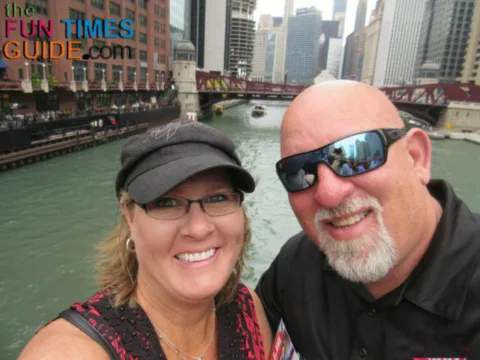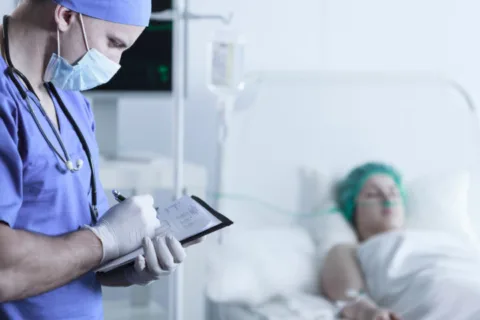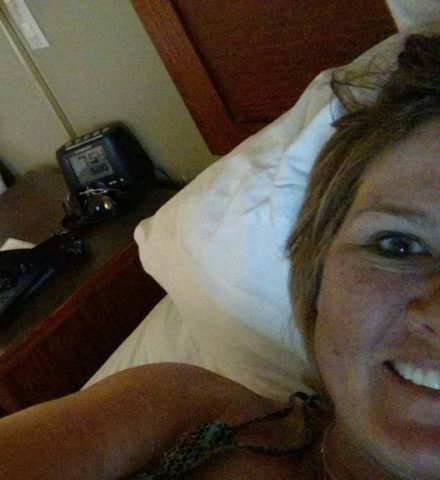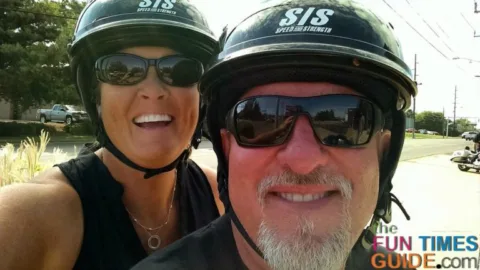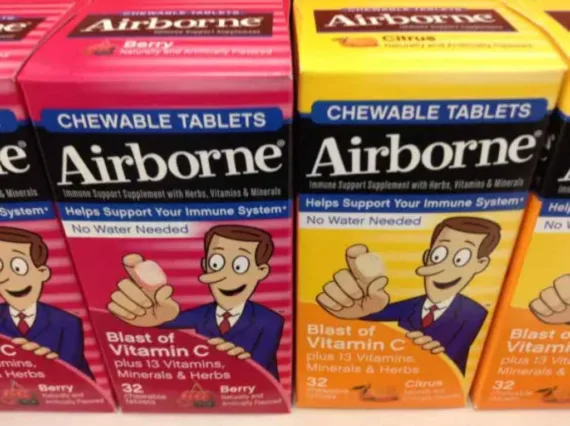I recently had a full hysterectomy — at the age of 50.
The reasons for my surgery:
- Endometriosis; and
- Ovarian cysts (on both ovaries); and
- Painful sex – thanks to tumors growing on the back side of my uterus combined with having a lower-than-normal tilted uterus to begin with.
For some women, the retroverted (tilted) uterus is very problematic. Because of its very low position in the pelvis, the body of the uterus and the ovaries are very susceptible to trauma from intercourse. From a functional point of view, one might think of the vagina as being very shallow, as the male can very easily bump the uterus and ovaries during intercourse, and this can be very uncomfortable.
—obgyn.net
My symptoms and pain level were quite similar to the endometriosis and ovarian cysts that I experienced 9 years earlier. At that time, I had a laparoscopy. After that surgery, I took low-dose birth control (every day) to keep new fibroids from growing back as rapidly.
Fibroids are non-cancerous growths that originate from the muscle of the womb (or uterus). They affect 80% of all women, and some patients suffer from heavy bleeding & pain.
—InnovativeGyn
I always knew that new tumors could reappear. It’s to be expected when you have endometriosis that the pain, fibroids, and tumors (either benign or malignant tumors – mine have always been benign) will return at some point in the future — because once you’ve been diagnosed with endometriosis, you always have endometriosis.
Due to my age and other issues that I explain more below, they decided that a full hysterectomy would be the best course of action this time, followed by hormone replacement therapy. With surgical menopause, the hormones should lessen the severity of menopausal symptoms after the hysterectomy. (That was the plan anyway.)
Two interesting quotes that kind of bummed me out before my surgery:
- “Estrogen therapy can help relieve uncomfortable symptoms of menopause. However, oral hormone therapy carries increased risks of stroke, blood clots like deep vein thrombosis, and heart disease — which you should also discuss with your doctor.” —EverydayHealth
- “Some women who take menopausal hormone therapy may still have symptoms of endometriosis.” —WomensHealth.gov
What My Hysterectomy Surgery Was Like
Mine was a total hysterectomy where they removed the entire uterus, cervix, Fallopian tubes, and ovaries.
Hysterectomy for benign gynecologic disease is one of the most commonly performed procedures for women. Overall, 1 in 9 women in the United States will undergo the procedure during her lifetime.
—Jama
I had the robotic hysterectomy surgery called daVinci hysterectomy. The robotic surgical platform received approval from the US Food and Drug Administration in 2005.
The daVinci method is best for women with hysterectomy complications — ranging from minor to major. It was the best option for me for these reasons:
- My age (50).
- Severe scarring from the endometriosis.
- I have a tilted uterus AND it’s positioned lower than usual AND my ovaries are located behind my uterus — which is unusual. Typically, the ovaries are free-floating to the sides of the uterus. But mine are attached to the back of my uterus by lots of fibroids.
- The surgeon who is most skilled with doing this type of surgery here in Nashville is also a gynecological cancer doctor — so if the tumors turned out to be cancerous (determined only after removing them), then I’d be in the best hands already.
If a laparoscopic procedure is not possible and a traditional abdominal incision is the only option, that’s where robotics comes in and is truly beneficial. This is typically the case if someone has cancer, a lot of scar tissue, or a very large uterus so even skilled laparoscopic surgeons can’t get the visualization they need to do highly technical work. In these cases, the result of using robotics is shorter operating times, less blood loss, fewer complications, and much shorter recoveries (assuming your surgeon is skilled and very experienced at doing robotic surgery). However, if your doctor says your surgery can be safely performed laparoscopically, there is likely no benefit (beyond the “cool factor”) to a robotic procedure.
—Dr. Oz
This 2-hour video shows exactly what the process of a full daVinci hysterectomy is like using the robotic arms.
Here’s a short 2-minute version that simply shows the basics of what they do during a full daVinci hysterectomy surgery:
Questions I Had On The Day Of Surgery
In the days between your pre-op meeting with the surgeon and your actual surgery, many questions are sure to come to mind — things you couldn’t have possibly thought of in time for your pre-op meeting.
These were my questions that I made sure to ask at the hospital before I got the anesthesia — they’re all based on the fact that you’re not supposed to lift anything heavier than a milk jug for 6 weeks after surgery, and you’re not supposed to lift or strain in any way:
- Can I roll our heavy trash barrels to the curb on their wheels? What about vacuuming back and forth? (Answer: You can do these things after 2 to 3 weeks.)
- What about bending over to pick up dog bowls to refill them with food & water? Is there any reason I shouldn’t bend over for awhile? (Answer: If you need to reach something down low, just be sure to squat from your knees rather than bending over at the waist. The only chance you could tear the stitches is if you lift more than 5 pounds — not by squatting or bending alone.)
- What’s the worst thing I could do during my recovery period? What should I be most careful of? (Answer: A hernia! So I made sure not to lift anything heavier than a half gallon jug during the first week. Then I moved up to a whole gallon jug the 2nd week after surgery.)
- Can I walk up stairs? (Answer: Yes, but just 1 flight per day for the first few days.)
- You can drive a car just 5 days after surgery… but when can I ride on the back of a motorcycle again? I don’t have to wait the full 6 weeks for that, do I? (Answer: YES… You have to wait! No motorcycle riding of any kind until after the 6-week check-up. One woman that my surgeon had operated on ruptured her sutures on a motorcycle ride… so don’t do it!)
- What’s the best way to get out of bed? Ours is a deep foam bed and you really sink into it. (Answer: Try using your arms instead of your abs to get yourself up to a sitting position and then out of the bed. You can place one arm behind you to help you push up to a sitting position. Then spin on your bottom to get your feet off the bed. Finally, try to roll from your side into a standing position.)
- Is it best to sit up or lay down during the first few days at home? (Answer: Whatever feels best for you. You can even lie on your side or your tummy if it’s comfortable for you. I definitely preferred lying on my back… HOWEVER, after 5 days of doing that, my lower back and kidneys became very sore. So I started to sit in a large comfy chair instead of lying down so much. It took awhile for sleeping on my side to feel comfortable for me, and there was absolutely no way I was going to lie on my sutured tummy!)
- At 6 weeks I will probably be healed. So does that mean at 3 weeks that I won’t have to worry about hemorrhaging or ripping the stitches any longer? This was only on my mind because a friend of mine said she started hemorrhaging several days after her surgery. So I wondered when you can stop worrying about that possibly happening. (Answer: About 1 month after surgery.)
- And as I was being wheeled from pre-surgery into the operating room (half-sedated already), this was the question I decided to ask: “Can someone please take a picture of the parts that you remove from me?” What can I say, I like to document my life in pictures. And I’m a blogger… so the chances were good that I was going to write about this experience… and everyone knows that readers appreciate good pictures! (Answer from the anesthesiologist and the nurse – the only ones in the room at the moment: “Um… I don’t think we can do that. There’s a strict policy of no cameras or phones allowed in here.”) I’m laughing at myself now for asking that question!
What It’s Like After Hysterectomy Surgery
- You cannot take tub baths for 6 weeks. No swimming or hot tubs either.
- You can shower the day after your surgery.
- You can drive a motor vehicle after 5 days, as long as you’re no longer taking narcotics for pain.
- You can return to work in 1 to 2 weeks.
- Light walking is the most exercise you can do for 6 weeks.
- No sexual intercourse for at least 6 weeks, if you had your cervix removed (like me) — because it takes that long for the back of the vagina to heal. And… the type of material they use for the sutures would feel like glass on a man’s penis.
Here’s a good idea of what you can expect after hysterectomy surgery.
What Hysterectomy Recovery Pain Is Like
#1 – Basically the only pain I felt immediately after surgery was the sharp pain you feel when moving too quickly or bending down too far or stretching too far to reach something. That pain is the result of all the air inside your belly leaving very little room for extra movements. Having a “swelly belly” is normal for 2 to 4 weeks after hysterectomy surgery. It will eventually go away on its own.
I was put on Loritab every 6 hours after surgery. My pain level was relatively low (3 out of 10), but I told the nurse (and the surgeon) that the Loritab was doing nothing to reduce that pain. Basically, the Loritab was having no effect on me.
So they switched me to Percocet (oxycodone/acetaminophin 7.5mg/3.25mg) and it helped right away. I was allowed to take 1 to 2 pills every 4 to 6 hours. I took 1 pill every 4 hours until Day 5 after surgery when I went to 1 pill every 6 hours. After that, I went to 800 mg Ibuprofen as needed for pain (maximum 3200 mg per day).
From the get-go, they all kept saying that I have an extremely high tolerance for pain. (Which I already knew.)
I was eagerly getting out of bed to use the bathroom and walking on my own without thinking twice — even though I was still on an IV drip and had to push that rolling cart everywhere I went. By the way, they leave the catheter in after surgery and remove it while you’re fully awake a few hours later (absolutely no big deal). Then, they monitor how frequently, and how much you pee — to verify that you don’t have post-operative urinary retention.
#2 – Immediately after surgery, I had a little bit of discharge on the maxi pad and a little bit of back pain too — nothing bad at all. Unfortunately, the lower back pain (and kidney pain) came back with a vengeance at 3 and 4 days after surgery.
I wasn’t sure if the intense back pain that I started re-experiencing was due to lying in bed for way too many hours at a time. Or if it was maybe due to the fact that they had to probe my kidneys (especially the right one) due to all the scarring from endometriosis that they found during the hysterectomy surgery itself.
Whatever the cause, it was painful just to stand up straight or to walk around without the back pain.
I decided to spend the next few days sitting up more than lying down — and it seemed to help. The back pain pretty much went away, except for when I was lying on my back.
#3 – For what it’s worth, I experienced a really weird sensation 24 hours after surgery. Within 10 minutes of the nurse giving me a Tramadol shot in the arm muscle, my lower jaw and the glands on either side of my face (under my ears) got really sensitive.
My jaw felt slightly locked up and tight — almost the feeling when you’re going to throw up, but worse. And my glands swelled a little, were sensitive to touch, and felt very warm.
The nurse said it had absolutely nothing to do with the shot — which I’m not so sure. Although perhaps it was just the timing. Maybe my surgery meds had just completely wore of at that time and this was a side effect of the trach tube being in my throat or something.
Anyway, the fevered and swollen glands and strange lower jaw sensation lasted for 2 more days at home. Then it just went away. (I was very relieved when it did.)
#4 – Immediately after surgery and for several days afterwards, the worst pain of all was the chest air bubbles — way up high near my shoulder or collarbone. It wasn’t unbearable, but it made taking deep breaths hard to do.
By Day 6 after surgery, my upper chest pain was pretty much gone. Only the belly pains remained.
In order to see the pelvic organs during laparoscopic surgery, we need to put carbon dioxide gas (CO2) into the abdomen which pushes the bowel out of the way. If the CO2 is left in the abdomen, it can irritate the nerve under the diaphragms. This nerve runs close to the nerves for your shoulder and the gas will cause shoulder and back pain. The pain can be sharp and can last for a day or two. Sometimes changing position can help, but over time the pain will go away.
—FibroidSecondOpinion.com
#5 – During the first 4 days at home, my pain was pretty much non-existent — as long as I stayed on the pain meds. I just had the regular belly soreness that’s to be expected.
Half of my belly pain was due to sore abdominal muscles (like from doing too many sit-ups). This was accumulated pain from getting up and down a lot — especially from a lying down position.
The other half of my belly pain was due to the surgery tugging and scraping — combined with a lot of air still residing in my belly.
On Day 6 after surgery, I started taking GasX tablets which helped my belly start releasing more of the air.
My Best Tips To Speed Up Your Hysterectomy Recovery
In addition to all of the tips that I’ve sprinkled throughout this article, here are 8 of my best recovery takeaways for you — if you’re preparing for a hysterectomy soon:
#1 – Use the pH balanced shower soap they give you. Or buy your own (like Vagisil or Summers Eve) liquid shower soap that’s pH-balanced for a woman.
Even though you can shower the day after your surgery, I actually waited until 3 days after surgery to take my first shower. I just didn’t like the thought of soap and shampoo settling into my sutures. After that, I took a shower every other day.
It gave me some peace of mind to know that I wasn’t using harsh soaps near my surgical sites.
Oh yeah… you can remove the dressing on your stomach sutures after you get home — just leave the steri-strips in place until they fall off on their own. (They can obviously get wet in the shower.)
#2 – You have to “prepare” yourself for that very first bowel movement. I knew from my last endometriosis surgery that you might not have a BM for a week or so following surgery (4 to 5 days is most common) for these reasons:
- The anesthesia paralyzes the bowels, so they have to “wake up” in order to begin to function properly again.
- The pain meds they put you on typically cause constipation — something you don’t want to deal with when you’ve got stitches inside and out.
- You don’t eat much in the days following surgery — which doesn’t help your situation much.
I also learned from my last surgery, that if you do nothing precautionary to help the situation, then you will end up with what feels like a rock inside your bowels! And there’s no way you’re passing that without some help (and a lot of pain that could’ve been avoided).
So, to prevent the constipation and pain this time, I decided to “prep my bowels” using some advice from my surgeon, some advice from the post-op recovery care nurses, and some advice from other hysterectomy patients who’ve shared their experiences online in the past.
For me, it was on the morning of Day 4 after surgery that I started to prep my bowels for their first BM — because that was the first time that I slightly felt the urge to go on my own, and I was starting to eat more solid foods at this point.
I wanted my first few bowel movements to be very loose stools… and they were! No pain or straining whatsoever. (And no, it wasn’t watery either.) Here’s what I did — starting on Day 4:
- I took 1 tablespoon of Milk of Magnesia with my first meal each day.
- I took 1 Colace pill with each subsequent meal (not with each snack though) every day.
The Milk of Magnesia is a laxative, so it works almost immediately (for me). I only took it if I knew that I was going to be near a toilet and only if I had enough of an urge to go on my own already.
The Colace is a stool softener, so it takes 2 or 3 days to work. I used the Colace pills more as an ongoing constipation preventative until I no longer worried about straining or tearing any stitches.
Once I had gone through all the pain pills (at 1 week post-op), I stopped taking the Milk of Magnesia and instead took the Colace with every big meal. It worked just enough to prevent straining, while still having solid BM’s.
I kept the Milk of Magnesia in the fridge (even though they say you shouldn’t). It still worked — almost immediately — for me.
For what it’s worth, I felt fresher when I used flushable wipes instead of regular toilet paper.
#3 – There are ways to eliminate the pain — sort of.
Half the discomfort is food and air passing thru your bowels after surgery — a reason to eat light for several days to reduce the pressure there.
The other half of the pain is from the intense amount of air inside your belly that makes the sutures much more noticeable internally.
Short but sharp pains whenever you use your abdominal muscles are to be expected.
My best advice is try to use your arms to get up (more than using your stomach muscles) — it helps a little. Also good to know: chewing gum can help with bowel function. So can bending your legs while you’re lying on your back.
Your bowel takes time to recover from surgery. By the time you are discharged, you should be passing “gas” or flatus. This should continue once you are home. Your first bowel movement should occur 4 to 5 days after surgery. You may experience “gas” pain. Drinking hot liquids and walking will help relieve discomfort. You should use a stool softener such as Colace (docusate) and a mild laxative such as Senekot (sennosides) or Milk of Magnesia, which you can purchase at the drugstore. You should continue the Colace and laxative until you have stopped taking the pain medication or your stools become unusually loose.
—DanaFarber.org
Right after surgery, I was terrified of sneezing. Ow, that would hurt! If you, too, have a fear of sneezing after surgery, most women who’ve had hysterectomies recommend that you have a small tummy pillow on hand at all times.
#4 – Buy a comfy night shirt (or two) that you’ll look great in — ahead of time.
I did not do this, and I wish I would have.
I lived in night shirts and those mesh underwear from the hospital for the first 7 days after surgery.
You’re definitely not looking your best (or feeling your best), so any little thing you can do to help with that, the better you’ll feel about yourself.
And who wants their husband to see them looking so blah for so many days in a row? A simple change to a new nightshirt — rather than an old ratty one — would have done wonders for my self-esteem in those first days and weeks after surgery. A little mascara helped a bit, but a new nightshirt would have been better.
It wan’t until I had to leave the house that I’d put on “real” clothes. At 2 weeks post-op, that consisted of the same outfit I wore to and from the hospital:
- loose-fitting sweat pants
- a zip-up sweatshirt
- slip-on shoes
It wasn’t until the 3rd week after surgery that I started wearing jeans again.
By the way, they say to wear loose clothes after surgery. In my case, the surgical wounds from my robotic surgery were positioned higher than the bikini line — even higher than any underwear waistband. I wore lightweight underwear that had a super thin waistband anyway. I also wore larger than normal sweat pants — so there was no chance of any binding or grabbing anywhere near the stomach stitches.
#5 – Buy a lights-on, lights-off Clapper! Seriously.
Because I’m weird (or lazy), I had actually put a Clapper in our bedroom a year or so before my hysterectomy. I just got tired of getting all the way out of bed just to turn off the lamp each night before bed.
Now all we do is knock twice on the headboard of our bed and the lamp magically turns ON or OFF. It’s as easy as that.
But it wasn’t until after my hysterectomy surgery that I realized just how brilliant this little invention is!
The last thing you want to do after surgery is stretch and reach and strain (…and get out of bed any more than you have to).
So I was extra pleased when the Clapper came in so handy in those days and weeks after my hysterectomy. And believe it or not, it’s such a convenience that we still use it every single day in our bedroom!
#6 – You can get through the recovery period alone, if you have to.
My husband was originally going to be out of town starting 2 days after my surgery — for 1 week. So I was fully prepared to get through my hysterectomy recovery alone. But then he got sick himself and couldn’t travel.
Fortunately, I had prepared to take care of things myself through my first week at home recovering. Because not only did I have to care for myself during this time, but I also had to help him get through a long bout with diarrhea, headache, and a pinched nerve.
I say all that to let single people or those without family know that you can get through the first week of post-hysterectomy recovery on your own — if you have to. Just do the things that I’ve mentioned in my post about how to prepare for a hysterectomy, so your home and your kitchen will be arranged to best meet your needs throughout your recovery.
#7 – I took some comfort in knowing that a fever over 100.5 is the signal to call the doctor.
You’ll have aches and pains. You’ll wonder if this ache or this pain is different from the others.
For me, the bottom line was… if there’s a fever, then you know there’s an infection and something’s wrong.
I liked knowing that I had the personal email address for my surgeon’s office assistant — so I didn’t even have to call and ask my stupid questions. I could just email her and she’d get right back to me.
It’s comforting to know that you have a phone-a-friend, or a lifeline like that when you’re feeling so vulnerable.
While in bed after my hysterectomy, I also did a lot of research and found answers to many of my hysterectomy & female anatomy questions like:
And I got a lot of personal reassurance from this great hysterectomy website:
#8 – Have some menstrual pads on hand for post-surgery bleeding.
As far as vaginal bleeding after the hysterectomy, I spotted the first day after surgery (not the evening right after surgery though) — enough to require a maxi pad, but not enough to use the whole pad.
After that, I continued to wear a thin maxi pad — just in case.
I didn’t start spotting again until 9 days after the hysterectomy. I remembered the surgeon saying not to become nervous if the vaginal bleeding didn’t start until 10 or 12 days after surgery, so I didn’t panic. But it sure is weird when you’re starting to feel “good” and then you see enough blood that requires a thin pad daily.
That’s when I explored all the reasons for vaginal bleeding after a hysterectomy:
- Post Hysterectomy Bleeding
- Bleeding After A Hysterectomy: What’s Normal?
- Spotting vs Bleeding After Hysterectomy
By the way, the blood after a hysterectomy is pink (not red) and watery (not thick or clotted).
I changed my pad twice a day because I took a shower twice a day — just to try to keep the area clean. (I do not like feeling “not fresh”.)
What My Recovery Was Like, Week By Week
At 4 weeks post-op:
The doctor said I had started doing too much too fast.
Right before my 4-week appointment, I had spent the previous 2 afternoons shopping for and trying on clothes — plus buying groceries while pushing a heavy loaded shopping cart at Costco. As a result, my belly started to hurt any time I’d turn or move quickly. Sudden movements (and even some regular movements) during the course of the day at home felt like I had knots deep inside my stomach that were stretching or tearing.
Before exerting myself by shopping for clothes and groceries, I had pretty much stopped spotting at 4 weeks. But the spotting started again after my 2 afternoons of shopping. I stopped spotting for good about a week later.
Between 4 and 5 weeks post-op:
The last of my 6 suture coverings had fallen off my stomach area.
By 5 weeks, my scars looked so much better. I could tell these were going to heal nicely and leave little to no scars.
Some women start adding a scar preventative (like Mederma) a few weeks after surgery. But I didn’t do that with my first laparoscopy 9 years earlier — and those scars are completely invisible today — so I didn’t go to the trouble to use a scar cream after this surgery either.
Now, several months after my hysterectomy, there’s only one scar from this surgery that is still noticeable (the one above my belly button). But it’s not bad at all — just a light pink line.
At 5 weeks post-op:
I felt 100% like my normal myself, and I felt like I could do just about anything without any pain or even a memory that I’d recently had a hysterectomy.
So, it was frustrating that I had to wait another 2 weeks to get the “all clear” from my doctor.
While you’re generally supposed to wait 6 weeks before going back to your normal lifestyle of living, exercising, and sex, my doctor made me wait an extra week by scheduling our first follow-up appointment for 7 weeks after surgery (instead of the normal 6 weeks).
On rare occasion, if I moved quickly from a weird position (like while dusting the baseboards) — I’d feel a twinge deep in my stomach — similar to the tearing/stretching feeling I had before with what felt like knots deep inside my stomach.
At 5 weeks, we had a warm spell weather-wise in the middle of January, and I wanted to hop on the back of hubby’s motorcycle with him so bad — but I didn’t. We ride together a lot (mostly over long distances for weeks at a time) and this surgery had put a huge damper in our motorcycle riding habits.
By the way, I had made a point to ask my doctor prior to the hysterectomy when I’d be able to ride on the back of a motorcycle again, and she was adamant that there should be no riding whatsoever until she checks me at the 7-week post-op appointment.
At 7 weeks post-op:
The doctor said the stitches hadn’t dissolved yet inside my vagina — so no sex for at least 3 more weeks.
She warned to not even try it because the sutures have tiny prongs on top which hubby would not find comfortable at all. Besides, if we had sex and ruptured the sutures, there would be many more weeks of abstinence and surgeries to repair the damage.
When she first said no sex, I immediately broke into tears – because my husband had been so awesome through all of this. She said she carries around a pack of prescription forms that just say, “NO SEX!” and she gives them to wives to give to their husbands. I thought that was pretty hilarious.
She said still do no lifting of anything over 10 lbs. Still no motorcycle riding. Take it easy for 3 more weeks. Ugh!!!
Baths are okay now — which helped me a lot with feeling fresh and getting rid of that lingering odor from being “closed up” for so long.
Doc said the feelings of knots in the stomach are actually scar tissue stretching as you move or turn — nothing to be worried about. It will continue for many months, but will eventually go away.
This was the biggest eye-opener for me at this post-op checkup: My doctor said that hormones won’t work for me because the endometriosis was so bad in my case that even the slightest bit of estrogen would cause the endometriosis to flare up again in a bad way.
So, I was prescribed Venlafaxine (or Effexor) to see if it would help with my hot flashes — which I was experiencing mostly in the mornings and evenings. I started with a low dose (37.5 mg). It’s an anti-depressant that is well-known to help with hot flashes in pre-and post-menipausal women. For hot flashes, it’s prescribed at much lower doses than is normal for treating depression (200 mg). The only downside: it can make you have insomnia — so be sure take it early in the mornings!
Of the 4 antidepressants studied, paroxetine (Paxil, generic) and venlafaxine (Effexor, generic) appeared to be the most effective, reducing the frequency and severity of hot flashes by 65% and 57%, respectively.
— ConsumerReports.org
Even though I still had some vaginal odor that drove me absolutely batty, the doctor said there was no infection, so she couldn’t prescribe a medication to help. (A few days post-op, I was having super fishy smells — even right after a shower. I emailed the doctor and she prescribed an antibiotic which helped right away. But she didn’t want me to go that route again.) She said a very gentle douche might help if I was really that concerned about the smell — but douching with apple cider vinegar would be too harsh. So, I just sat in a bathtub for longer than normal instead of douching. It helped a lot.
Whether you had a vaginal or abdominal hysterectomy, this odor is likely caused by dissolving stitches, along with old blood and other fluids in the abdominal cavity. This is particularly common with surgeries that involve anterior and posterior repairs because of the additional stitches from these procedures. Some women also notice that their urine smells a bit different — this is usually caused by anesthesia and other medications.
— Hyster Sisters
There was one other thing that I was wondering about at this point… how deep is my vagina now since clipping it off at the cervix? She said it’s about the same length as before (about 3 inches) and it stays in place with the ligaments that remained in place after the surgery. Human anatomy is amazing!
At 10 weeks post-op:
My doctor said the stitches had still not yet fully dissolved inside my vagina. While dissolvable sutures usually disappear after several weeks for most people, some peoples’ bodies simply do not break down the sutures as quickly or easily — so they need to be manually removed. That’s what happened to me.
I asked what the sutures were made of. She said a sugar substance that your body’s enzymes typically break down naturally.
It wasn’t painful at all to have the sutures removed manually at 10 weeks post-op. She reached in with a pair of tweezers that were close to 1 foot long and plucked them out, one by one. I could feel very light twinges inside — she said that was normal too.
The only bummer: the doctor said to give those spots where the sutures were an extra week to heal on their own. She said to abstain from sex for 1 more week. Ugh! That amounted to 11 weeks of abstinence since I had the surgery.
The only good news at my 10-week post-op appointment: I could begin exercising, lifting things, and motorcycling again — yay!
It was at this appointment that we increased my dosage of the Venlafaxine (or Effexor) — because my hot flashes were still occurring quite regularly. I’m now taking the standard dose for hot flashes: 75 mg and haven’t had any bad hot flashes since then.
Traditionally, hot flashes have been treated using estrogen therapy, which can provide 95% efficacy for these vasomotor symptoms. However, the benefit of estrogen use may not outweigh the risk in certain populations of women including breast cancer survivors or those at increased risk of stroke.
— Medscape
At 11 weeks post-op:
Wouldn’t you know it. At the 11-week mark after we’d gotten the “all clear” for sex, hubby had to be out of town for work.
You can bet I was ready for him when he got home at 12 weeks post-op! Except for one thing…
I got too ready for him. For a couple of days before he got home, I started using Caress Body Wash for the first time ever. It’s “the world’s first body wash with Fragrance Release Pearls that release fine fragrance for up to 12 hours with a touch of your skin” because — as you know by now — I don’t like bad smells.
Unfortunately, I used it on a shower puff everywhere — and I ended up with a really bad vaginal infection!
I went back to the doctor to make sure it wasn’t anything worse than that. (It wasn’t.) And before I left — with antibiotics in hand — I made sure it was okay to still have sex because we had waited so long for this. She said while she didn’t recommend anyone with a vaginal infection having sex, it shouldn’t hurt anything if we did. Life was good again.
Things I Wish I Knew Before My Hysterectomy
Now that all is said and done, these are the things I wish I had known ahead of time:
- You still might experience painful sex after a hysterectomy.
- There are possible bowel & bladder issues that can occur after a full hysterectomy.
- A lack of sex drive after hysterectomy (especially when taking vexlafaxine) is common.
- Even without all of your working inner parts, you can still continue to have endometriosis issues.
- Vaginal odor issues immediately after surgery are common.
- When to stop worrying about hurting myself over little things — like coughing, bending over, lifting, etc.
And here are 3 more questions that I asked my regular gynecologist, after my post-op appointments with the surgeon were done:
#1 – How in the world can endometriosis reappear when there’s nothing left in there for the fibroids to attach to?
Answer: Once you have endo, you always have endo. Even with a total hysterectomy, there are microscopic fibroids still left behind that will remain dormant unless you re-introduce estrogen into your body. If you don’t take estrogen hormones, then you most likely won’t have any more endometriosis problems. If you do take estrogen, the fibroids will reappear in your pelvic area.
Here’s more about the recurrence of endometriosis after a full hysterectomy.#2 – Do I need to take extra vitamins or supplements like Vitamin D or Calcium?
Answer: At first she said no. But after doing bloodwork, it was clear that my Vitamin D levels were too low. So I had to get a prescription to get a dose of 10,000 IU of Vitamin D3 daily for 30 days, followed by taking 10,000 IU of Vitamin D3 once a week for 8 weeks. Then I spent the summer as usual and re-tested again with bloodwork in the fall. Again, my Vitamin D levels were too low. So I had to go through that exact same dosage of Vitamin D3 for another 12 weeks. After that, I was told to take 2,000 to 4,000 IU of Vitamin D3 daily on my own until we draw bloodwork again.
Postmenopausal women, especially those older than 70, should increase their daily vitamin D intake from 15 micrograms, or 600 IU, to 20 micrograms, or 800 IU, according to the National Institutes of Health Office of Dietary Supplements. The National Osteoporosis Foundation recommends even higher daily intakes of 800 to 1,000 IU of vitamin D. Since the Institute of Medicine sets the tolerable upper intake level — the maximum amount of a nutrient likely to pose no health risks — at 4,000 IU per day, women can safely take these increased amounts. Postmenopausal women should increase their calcium intake from 1,000 milligrams per day to 1,200 milligrams per day, according to the Institute of Medicine. If taking calcium supplements, be sure not to exceed the tolerable level of 2,000 milligrams per day.
— Jillian Michaels
In addition to the recommended Vitamin D3, I also plan to take some combination of Calcium and Magnesium. (I’ve heard it’s best to take 600 to 1200 mg of Calcium with 400 to 600 mg of Magnesium before bed — never at the same time as a multi-vitamin because the Calcium can block absorption of the other vitamins).
#3 – What about weight gain after hysterectomy?
Answer: I definitely gained at least 25 pounds within the first 8 or 9 months after my hysterectomy! It happened fast. In my opinion, weight gain is one of the worst side effects of having a hysterectomy. I’ve tried dieting and walking, but it doesn’t go away. I’ve finally come to grips with the fact that it’s my new normal.
If only doctors would warn women before their hysterectomy that most women gain weight in the first year — with an average weight gain of 25 pounds — it would likely make women more conscious about what they eat and their sedentary lifestyle.
— LifeAfterHysterectomy.com
Now, here are 50 things other women wish they had known before their hysterectomies.
Professionally, I pursued my Masters Degree in Family Therapy at Texas Tech — where I obtained invaluable expertise and experience helping people with a wide variety of physical and emotional health issues. Personally, I think it's useful when people realize that they're not the only one going through a difficult time. So any time that I think my personal health experiences would be helpful to someone else going through the same thing, I will share my story here. With health issues that I've personally experienced (like Endometriosis, Lyme Disease, Hysterectomy, Skin Cancer, Ganglion Cysts, Autism, and other topics that very few people enjoy talking about) and health products that I've found beneficial (like sleep aids, essential oils, and medications)… I do my best to provide my own raw and honest firsthand experiences that I think others would appreciate hearing about and (hopefully) find helpful. I'm grateful that I have a number of friends who have also been willing to share their very personal stories here — regarding their own physical and emotional health. When I'm not writing about health topics, you will find me sharing Good News & Fun Times as publisher of The Fun Times Guide (32 fun & helpful websites).

